Simon
Bolivar (SEE-mohn boh-LEE-vahr) was one of the most powerful figures in
world political history, leading the independence movement for six nations
(an area the size of modern Europe), with a personal story that is the
stuff of dramatic fiction. Yet today outside of Latin America, where he is
still practically worshipped, his name is almost unknown.
Born to
wealthy Creoles in Caracas, Venezuela, on July 24, 1783, his father died
when he was three and his mother six years later. Simon was reared by an
uncle with a tutor who exposed him to the writers of the Enlightenment,
such as Voltaire and Rousseau, who were inspirations for the French
Revolution. The tutor, Simon Rodriguez, fled the country when he was
suspected of conspiring to overthrow Spain's colonial rule in 1796.1
At 16, Bolivar
was sent to Spain to complete his education and on the way, his ship
stopped in Vera Cruz. During an audience with the viceroy, he audaciously
praised the French Revolution and American independence, both of which
made Spanish officials nervous.2
In 1802, he
married the daughter of a nobleman in Spain and returned to Caracas, only
to have her die a year later from yellow fever. As a way of keeping his
mind off of his grief, Bolivar decided to return to Europe to immerse
himself in the intellectual and political world he had found so
stimulating.3
While in
Paris, he met Alexander von Humboldt, the great naturalist who had just
returned after five years in South America. As von Humboldt spoke of the
enormous natural resources and wonders of the continent, Bolivar remarked,
"In truth, what a brilliant fate--that of the New World, if only its
people were freed of their yoke."
Von Humboldt
responded, "I believe that your country is ready for its
independence. But I can not see the man who is to achieve it." It was
a fateful comment Bolivar was to vividly recall the rest of his life.4
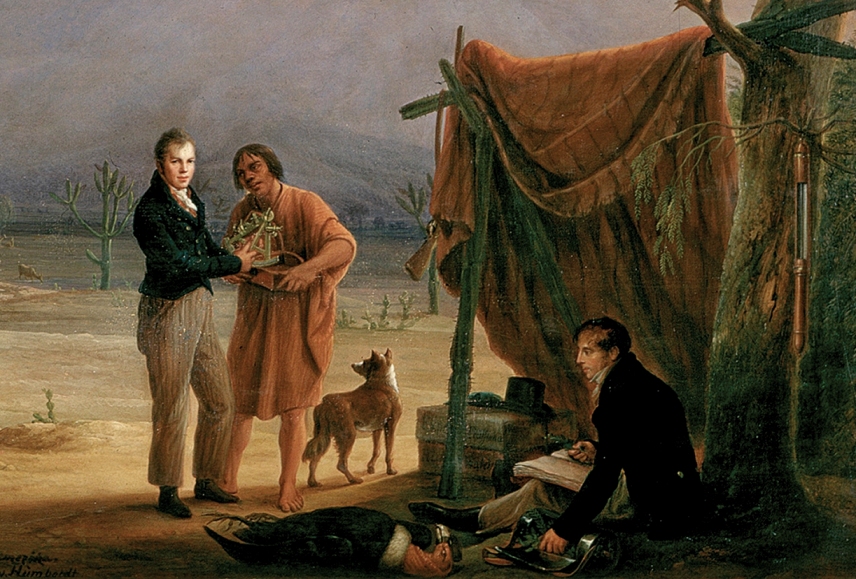
Naturalist Alexander von
Humboldt in Ecuador, 1806.
He also
witnessed the coronation of Napoleon as emperor on December 2, 1804.
Bolivar was appalled at what he felt was a betrayal of the principles of
the Revolution, yet he took note of the ability of one man to change the
course of history.5
Bolivar had
met up with his old tutor, Rodriguez, and the two traveled to Rome, where
they again crossed paths with von Humboldt. On August 15, 1805, Bolivar
found himself with Rodriguez on Monte Sacro (Aventine Hill), a place
associated in Roman history with freedom from oppression. The 22-year-old
feel to his knees and, grasping his teacher's hands, vowed to free his
country. After returning to Paris, Bolivar sailed for America, stopping
often along the east coast before arriving home in 1807.6
The following
year, France invaded Spain. By 1810, the city council of Caracas had grown
bold enough to depose the Spanish viceroy and sent Bolivar to London to
seek protection from the British government against any attempt by France
to seize Venezuela.7 No help was forthcoming, but Bolivar recruited
Francisco de Miranda, who had spearheaded a prior revolt, to return to
head the new independence movement.8 While in London, Bolivar also
had his most famous portrait painted. On close examination, a medallion
hanging from his neck reads, "There is no fatherland without
freedom."9 When he left on September 21, he was never to
return to Europe.10

Portrait of Francisco
de Miranda
As is typical
of revolutions before history is rewritten to present all the natives as
patriots, what followed in South America was as much civil war as an
effort to throw off the colonial yoke. The see-saw power struggle between
revolutionary and loyalist factions and with the royal forces was to last
14 years (followed by several years of occasional conflict between
factions in the liberated territories).
In March 1811,
a national congress met in Caracas. Though not a delegate, Bolivar gave
his first public speech to the group, saying, "Let us lay the
cornerstone of American freedom without fear. To hesitate is to
perish." The First Republic was declared July 5, Venezuela becoming
the first colony anywhere in the Spanish empire to attempt to break free.11
Like many in
the aristocracy, Bolivar had slaves, and in the spirit and excitement of
the independence movement he was the first to set them free. 12 He
was later to call for the abolition of slavery across the entire Western
Hemisphere.13
Although he
had no formal military training and no battlefield experience, Bolivar was
made Lieutenant Colonel serving under Miranda. He participated in his
first engagement on July 19, an assault on the Spanish stronghold of
Valencia in which he distinguished himself, but the rebel forces were
repelled. A siege forced capitulation on August 19th after
heavy losses on both sides. It was a harbinger of things to come.14
Miranda and
Bolivar had been having an increasing number of serious disagreements,
from how to treat counterrevolutionary conspirators (Bolivar was for
execution) to whether those born in Spain should be allowed to stay
(Bolivar wanted them expelled). Meanwhile, on the political front the
republicans were suffering from lack of governing experience. Within a few
months, the captured royal treasury was spent and a Spanish blockade led
to a worsening economic situation.15
On March 26,
1812, two years to the day after the Caracas city council had deposed the
viceroy, a severe earthquake hit the region, killing 10,000. Areas where
loyalists to Spain resided were little affected and religious hysteria
followed, blaming the independence movement for defying God's chosen
monarch. The Spanish commander-in- chief, Juan Domingo de Monteverde, took
advantage of the situation, marching out into the country, even finding
rebel units eager to switch sides. However, Miranda, who had 5,000 men vs.
Monteverde's 3,000, could have struck a decisive blow if he had gone on
the offensive instead of being overly cautious. In the few times they
clashed, Miranda held back his men from pursuit which could have
annihilated the Spanish.16
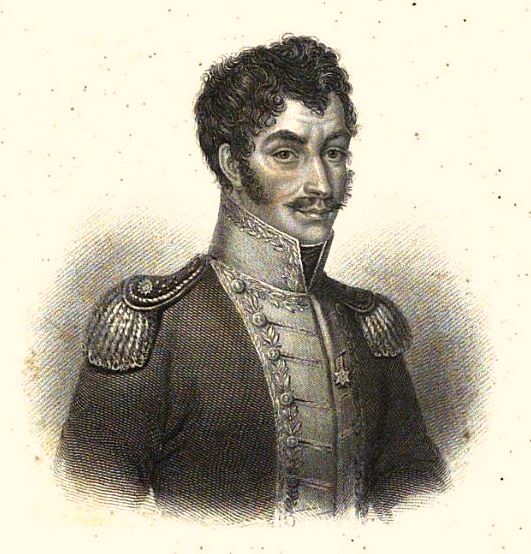
Portrait of Simon Bolivar, Published in 1837
Bolivar was
put in charge of the most important republican port, Puerto Cabello, where
a large number of prisoners were kept at the main fort, as well as a large
stockpile of arms and artillery (which played little role by either side
in South America's fight for freedom) . The combination proved fatal: a
traitor freed the prisoners who armed themselves and began bombarding
Bolivar's position. He and his men barely escaped with their lives.17
Bolivar felt
disgraced by the loss and furious that Miranda had not responded to calls
for help. Shortly thereafter, he and other officers turned Miranda over to
the Spaniards.18
As the Spanish
completed their reconquest of the country, Bolivar escaped to Cartagena in
New Granada (now Colombia), where rebels held power (though locked in
civil war with a rival faction in Bogata).19
There in 1812,
he wrote the first of his many eloquent political manifestos, saying,
"Not the Spanish, but our own disunity led us back into slavery. A
strong government could have changed everything." He began
championing a political system in which the nobility played a strong role,
led by a president for life. He condemned the leniency against crime in
general and against the state in particular that he felt had contributed
to the fall of the First Republic. He began arguing that Venezuela should
be liberated as the first step in creating an entire continent of
independent states.20
The government
of New Granada authorized a revolutionary force to liberate the
Spanish-held bastions in their territory and in Venezuela, headed by
Pierre Labatut. Against orders, Bolivar took 200 of the men and boldly
attacked a Spanish garrison, capturing supplies and boats. One small
victory followed another and the rebel ranks swelled.21
As a result of
his actions, Bolivar was named commander-in-chief of the entire New
Granadian army.22 He had to improvise tactics as he went along,
finding European tactics he read about in books useless in a land of
enormous mountain ranges, deep gorges, rushing rivers, vast plains, no
roads, minimal ability to communicate over any distance, and sparse
population.
Taking 650
men, he reentered Venezuela in May 1813. Facing 4,000 Spanish soldiers,
Bolivar's expedition seemed foolhardy. Using speed and surprise, he would
defeat units of the Spanish army and the population rose up to swell the
ranks of the republicans. He also recruited from the enemy by offering
amnesty for deserters, threatening to kill captured Spaniards. Though only
occasionally carried out, he believed that only through such a drastic
measure could the republicans win and avoid the slaughter and plunder of
civilians that was inevitable if they lost.23
After five
swift victories, Bolivar had built up an army of 2,500, which came across
1,200 of the enemy, who retreated swiftly towards Valencia. He placed two
men on each of 200 horses and had them ride around the Spanish through the
night. The Spanish found their way blocked in the early morning of July 31
and in the Battle of Taguanes the revolutionaries crushed the royalists.
It was Bolivar's first large-scale victory (by the small-scale standards
of South American war).24
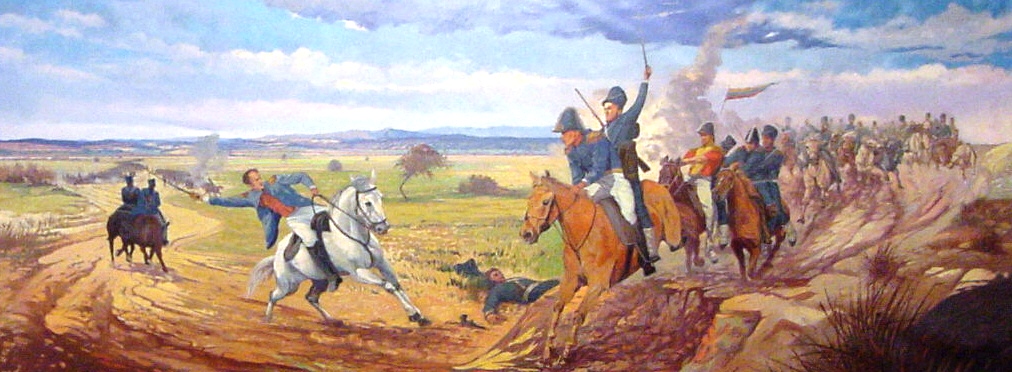
The Battle of Taguanes
The republican
army reentered Caracas on August 7, where Bolivar, now 30, was given
dictatorial powers, although half of Venezuela remained under control of
the crown, which had 10 times the number of troops, who were, of course,
much better equipped and trained.25
Gradually, the
population grew war-weary and sentiment turned against the independence
movement, which was also hindered by being poorly equipped (the infantry
typically had antiquated muskets which required six motions to load; often
running out of ammunition, they resorted to bayonet attacks, when they had
bayonets).26
The Spanish
leaders also began recruiting the fierce llaneros, nomadic
cattle-raising horsemen of the Amazon grasslands. They appointed Jose
Tomas Boves, a former rebel embittered by having been imprisoned by his
comrades, to head them. Known as the Legion of Hell, it consisted of as
many as 10,000 riders using spears, knives, and bolos, easily superior to
better-armed republicans, who were almost entirely infantry. They began
waging an even more savage war, so the rebels responded in kind, even
killing civilians who would not take up arms against the royalists.
Prisoners were executed on the spot. There was no grand war strategy, no
static fronts, just one pitched battle after another between a few hundred
or few thousand.27
On November
10, Bolivar inflicted what seemed to be a defeat on the llaneros
and Spanish soldiers at Barquisemeto, but in the midst of the pursuit by
the republicans, someone in their camped issued a call to retreat,
throwing the army into confusion and the roles were reversed, the Spanish
turning to pursue. It was Bolivar's first personal battlefield loss in
one-and-a-half years. The first regiment to retreat was stripped of its
medals, rank, and banners.28
Then on
December 5, at dawn, Bolivar's 3,000 attacked 5,000 Spanish forces under
General Monteverde, who were on in the hills near Araure. The patriot's
advance unit was immediately wiped out, but while Monteverde was
reinforcing his flanks where he expected the next assault, rebels armed
mostly with knives and sticks overran the center. After fierce
hand-to-hand combat, Bolivar himself led the charge which scattered the
Spanish. He gave chase until 2 a.m. the next morning, directing his men to
kill even those who surrendered.29
Over the next
few months, the patriots found themselves fighting on so many fronts that
they sometimes faced 7-to-1 odds. Bolivar's forces were nearly annihilated
several times.30
By February
1814, Bolivar had recruited some replacements and had dug in at San Mateo.
The Spanish, who had 10 times the cavalry, made repeated attacks on his
positions and nearly succeeded in overrunning them. At one point, they
almost captured the supply and munitions depot, until the defenders blew
themselves up to prevent its capture. The Spanish finally gave up after
several months.31
On May 28,
Bolivar's 5,000 faced 1,000 entrenched royalists in hills above the Plains
of Carabobo. Although his men were poorly armed, he knew that llaneros
were on the way to reinforce the enemy, so he decided to risk everything
again. The assault was so relentless that the Spanish fled.32
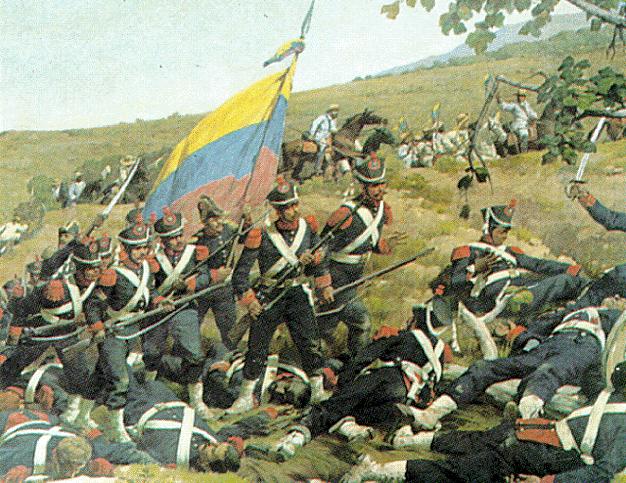
Batalla de Carabobo by Martín Tovar y Tovar
But with his
men nearly naked and the rainy season turning the region into a swamp,
Bolivar found it increasingly difficult to follow up, final victory always
slipping from his hands. On June 15, he gathered 3,000 soldiers at La
Puerta against Boves' equal number, and this time the revolutionaries were
trounced, Bolivar barely escaping from the field. As Boves marched onto
Caracas with his numbers increasing by the day, 20,000 fled the city.33
At Aragua,
Boves caught up with remnants of the patriot army and 4,000 men, mostly
Bolivar's, died in one of the bloodiest battles of the South American war
for independence.34
Bolivar
shipped 24 chests of church silver and gems to a safe point to buy arms
from British colonies and in September sailed to Cartagena.35 The
royalists gained control of Venezuela by the end of the year, reinforced
in May 1815 by 11,000 veterans of the Napoleonic wars, the biggest
expedition the Spanish had ever sent to the Americas.36
Ever the
optimist, Bolivar wrote his fellow citizens, "I have been chosen by
fate to break your chains…Fight and you shall win. For God grants
victory to perseverance." He exhorted his men that misfortune was the
"school of heroes."37
The government
of New Granada gave him an army to go after its own Spanish garrisons and
rebellious cities He sent out a public letter, pleading with the factions
to unite against Spain because "our country is America."38
But he was only partially successful in stopping the civil war and when a
large Spanish army arrived from Venezuela in May, Bolivar sailed for
Jamaica with most of his officers.39
There, the
prolific Bolivar wrote his most famous document, Letter from Jamaica,
in which he declared, "A people that love freedom will in the end be
free." He foresaw a great federation of Hispanic American republics
which would deserve the same respect as European nations.40
A man of great
charm who could size up the people he met instantly, the indefatigable
Bolivar set out to persuade the world to back his vision yet again. He was
said to speak so eloquently on the spur of the moment that his speeches
could be printed without editing. He answered every letter written to him,
sometimes dictating to three secretaries at once.41
Bolivar's
pleas fell on deaf ears as far as governments went, with the exception of
Haiti, whose president agreed to provide money and equipment. In March
1816, the first expedition sailed with 250 men in seven ships, an absurd
force to engage the 10,000-strong royal army. They came across four
Spanish vessels and were able to board two. They landed the next day at
San Juan Griego and were warmly welcomed by the people. Another 300 joined
what was called the Liberating Army. But shortly thereafter they were
driven back and returned to Haiti for reprovisioning.42
When Bolivar
landed in Venezuela again in December 1816, he was 33 and would remain
there for the rest of his life. He had 500 men with him; a nearby fort had
1,500 of the enemy, never mind the 16,000 government soldiers in Caracas.43
Bolivar began
circulating proclamations, making up stories about supposed victories in
various areas of the country, building an image of himself everywhere and
invincible. In actuality, he operated mostly on the plains around the
Orinoco river in the interior, headquartered in remote Agostura.44
And Bolivar
was actually spending much of his time quelling efforts by subordinates to
usurp his command. Bolivar showed excellent political skills in
maneuvering around the many internal roadblocks, but finally felt
compelled to execute the leading conspirator, Manuel Piar, who was,
unfortunately, was also the republicans' best tactician.45
One man became
indispensable to Bolivar's new strategy: Antonio Jose Paez, seven years
his younger (who had an enormous bodyguard called the First Negro who had
an knife so large no one else could wield it). Paez had mastered the
supreme difficulties of guerrilla cavalry warfare in the tropics. Some of
the llaneros were so impressed by him that they changed sides. His
lightning attacks achieved the first victories against the powerful army
which had landed in 1815.46
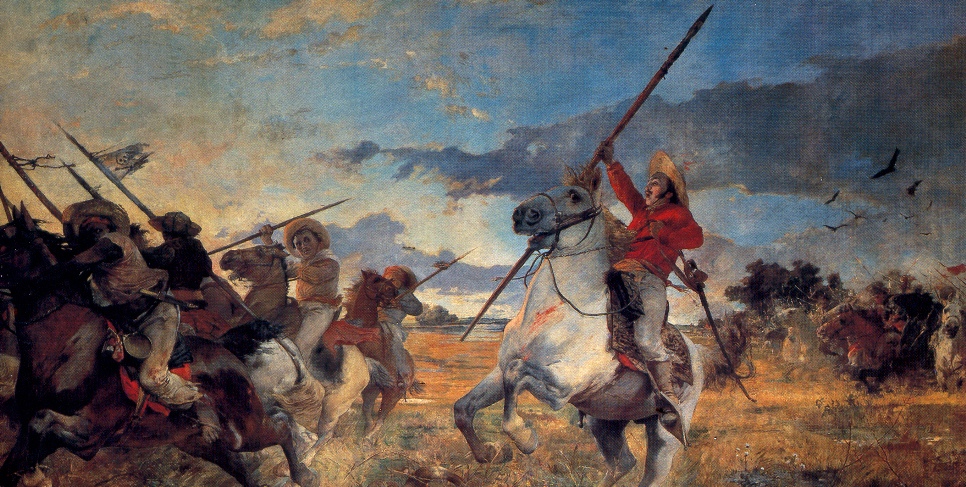
Antonio Jose Páez at the battle of Las Queseras
del Medio
By May, the
2,000 republicans had achieved some significant victories. One incident
illustrated how much they thrived on boldness. With 15 of his officers on
a reconnaissance, Bolivar spotted a large number of Spanish soldiers lying
in wait to ambush him as he rounded a corner. He shouted for his men to
form up and prepare for an assault on the enemy position--as if his own
army were right behind. The Spaniards retreated.47
In January
1818, Bolivar's 3,000 soldiers marched 350 miles through a swampy region
to join Paez's 1,000 cavalry. Armed mostly with lances and bows and
arrows, they surprised one Spanish garrison after another. The commander
if all Spanish forces in Venezuela and New Granada, Pablo Morillo, barely
escaped.48.
But
inevitably, Spanish numbers and arms turned the tide prevail. Bolivar
retreated to El Semen with 2,000 men and while he was passing baggage over
a ravine on March 25, royal forces attacked. The rebels were exhausted and
Morillo killed half of them, capturing their materiel and papers, though
Bolivar escaped. The Spanish were sure that he was finished this time.49
But Bolivar
was discouraged by the lack of popular support, but he still had Paez's
2,100 horsemen. He immediately began rebuilding the infantry by recruiting
from convalescent hospitals and among teenage boys.50
Gradually,
though, he realized that the only way to achieve a level of
professionalism to match the enemy was to form a foreign legion. He began
raising money and his agents found great interest among the 30,000
recently discharged soldiers of the British army. The weather and the
inability of the rebel army to meet payroll was discouraging to the
mercenaries, but they adapted to conditions and became committed to the
cause. Of the nearly 6000 who joined, 220 drowned on the way over, some
deserted, and most were died from disease or in battle: only a few hundred
survived the war.51
In February
1819, a republican congress was convened to draw up a constitution for the
Third Republic.52
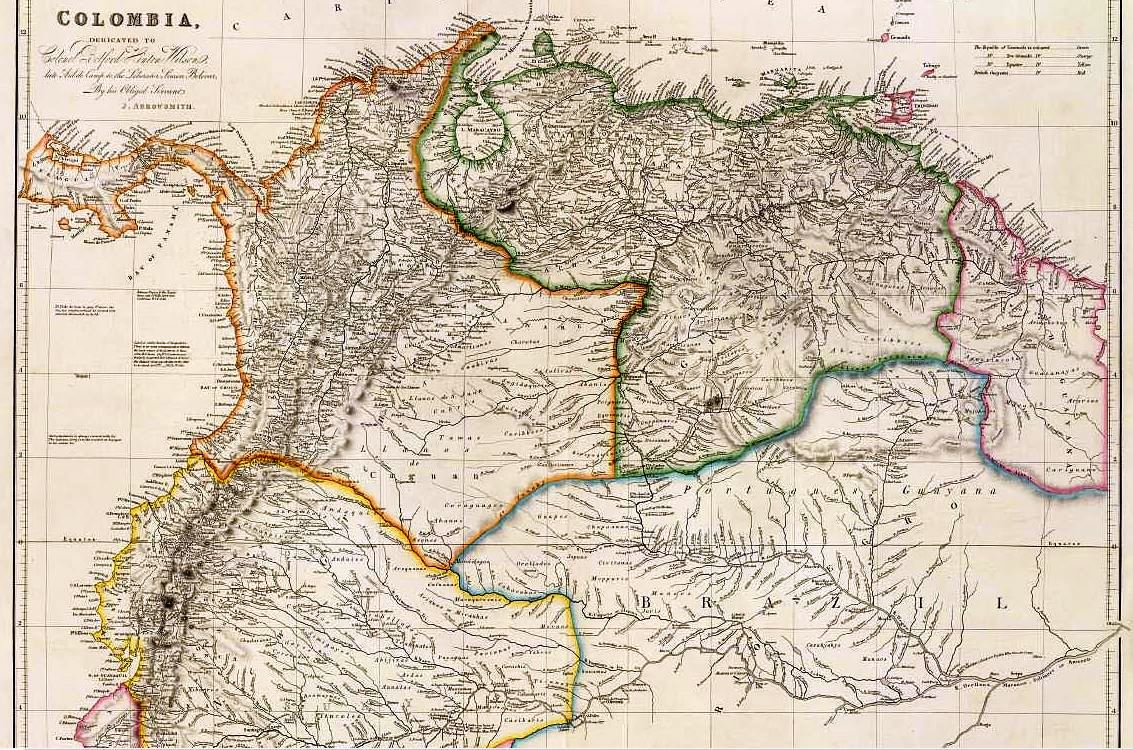
Map of Columbia, Published 1844
Meantime,
guerrilla warfare was being successfully waged by Paez's cavalry. In one
encounter, they lured the Spanish into a trap. The Venezuelans lost six,
the Spanish 400. The Spanish withdrew from the region after losing half
their 7,000 troops.53
Bolivar began
to conceive one of the most audacious military campaigns in history. He
had been operating on the eastern part of the Plains of Casanare. On the
western plains up against the Andes, Francisco de Paula Santander was
conducting a guerrilla campaign the Spanish found impossible to suppress.
During the rainy season when the plains were a virtual swamp, the royalist
troops withdrew and in April, Santander sent a message to Bolivar that the
area was free of the enemy.54
Bolivar knew
that the Andes were considered impassable during winter (in the southern
hemisphere) and that the Spanish guarded the frontier of New Granada on
the other side very lightly. He called a war council of his generals, all
of them under 40, in a hut without furniture; they sat on the bleached
skulls of oxen to discuss his idea on May 23.55
Hannibal had
spent years preparing for his epic trek through the Alps, as had San
Martin of Argentina when he made his own climb over the Andes, both with
seasoned soldiers. But within a week of making plans, Venezuela's 2,500
ragtag rebels set out to for the foot of the mountains.56 First,
though, they had to cross 10 swollen rivers, as well as move through
flooded plains with water often waist-deep, with the torrential rain
constant. Half the cattle brought along for food drowned. Bolivar
continually moved up and down his lines to exhort his men forward.57
On June 25,
they began the ascent into the mountains. The army consisted mostly
of men from the plains and Britain and Ireland, none of them prepared for
what they were about to face.58 The higher they went, the colder it
became. By the time they were at 18,000 feet, the horses and cattle had
died in the frozen wasteland.59 The half-naked men who had no wood
for fire most of the time, took to flogging each other to keep circulation
going.60 Nearly 1,000 men died along the way.61
Those who made
it to the other side of the range were half-starved and had dropped their
weapons along the way, but found a population eager to resupply them.62
After Bolivar's men had a few skirmishes with Spanish government outposts,
word reach the regional commander, who prepared to meet the rebels in a
well-defended position with 3,000 soldiers on July 24 at Pantano de
Vargas. After the revolutionaries' cavalry managed to charge in the steep
terrain and the foreign legion seemed to cinch a victory with a bayonet
assault, the Spanish pushed them back. It was a stalemate, but the
commander sent a report to the viceroy: "The annihilation of the
republicans appeared inevitable. But despair gave them courage. Our
infantry could not resist them."63
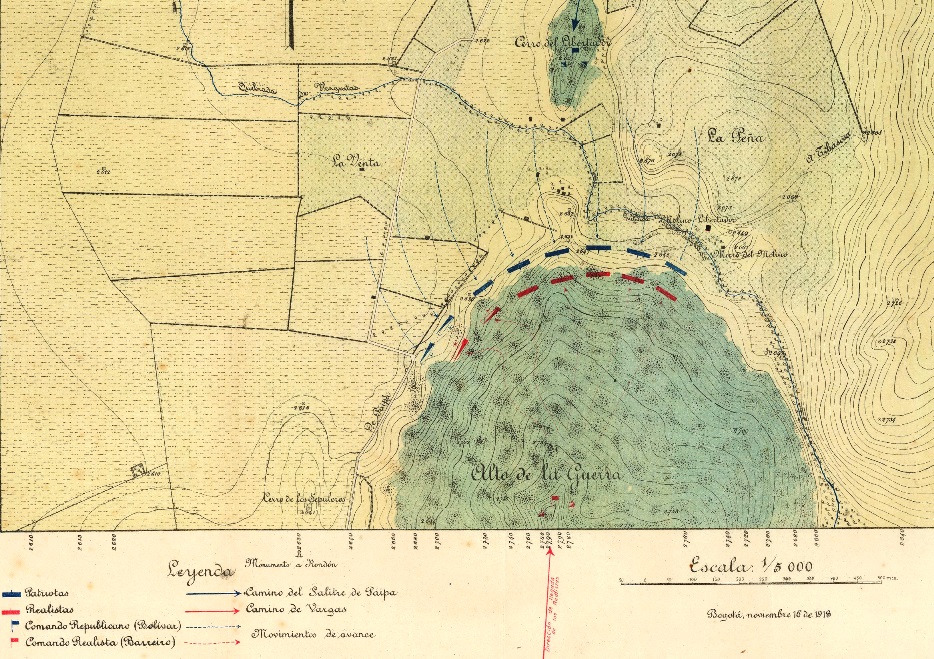
Battle of Pantano de Vargas
The Spanish
retreated and the patriots pursued. At Boyaca, on August 7, the rebels
prevented the royalists from crossing a bridge that would have allowed
them to reach the garrison at Bogata. In a two-hour clash, they captured
half of the 3,000 Spanish troops, the rest having been killed or fled the
battlefield.64 It was the turning point for the independence
movement in South America. The Spanish began to evacuate New Granada and
word spread like wildfire that the empire was coming to an end. Desertions
from the royal army increased and formerly neutral citizens began actively
supporting Bolivar.65
In December,
the underground legislature of Venezuela assembled and declared its
country and New Granada united as the Republic of Colombia (which included
what is now Ecuador). Bolivar was made president and military dictator.66
Political
events in Spain provided impetus for negotiations with the republicans
throughout 1820, but skirmishes continued.67 Bolivar and Morillo,
the Spanish commander, met in November and signed an armistice.68
In the following months, the patriots built up their army and made plans
for a campaign in the event a final agreement should not be worked out.
The conflict resumed in April 1821.69
On June 24,
the Spanish general La Torre brought 5,000 troops to Carabobo to block
both passes that could allow the rebels to move towards Caracas. He made
some decisive mistakes in position: a weak right flank, no sharpshooters
at the edges, and cavalry too far to the rear to be brought up in a timely
manner.
Bolivar, with
a total of 6,500 men, sent Paez with cavalry and infantry, including the
British battalion, around to the enemy's right rear, but while cutting
through the heavy bushes, that they were spotted. The Spanish reinforced
their right and concentrated fire on Paez's troops, repelling the initial
attack, which required the patriots to climb across steep ravines. But
when the overconfident Spanish broke out and chased them, the royalists
ran smack into the British veterans of the Napoleonic wars who cut them to
pieces with disciplined heavy fire at close range. Running out of
ammunition, the British charged with bayonets and the Spanish right
collapsed.
The main
forces of both sides had not yet engaged, but when Bolivar saw the outcome
on the right, he ordered a full attack. One-third of the Spanish troops
were captured and as many were killed or wounded.70
The region
between Cali (Colombia) and Guayaquil (Ecuador) remained a Spanish
stronghold after the victory at Carabobo. Bolivar had sent General Antonio
Jose Sucre south to aid the local revolutionaries and he had achieved some
success. In March 1822, Bolivar set out with 3,000 soldiers, but one third
of them perished from exposure or harassment from loyalist guerrillas.71
On April 7, he
came up against 1,800 Spanish troops in a seemingly impregnable position
in thick woods at Bombana. Bolivar ordered an attack on the right at night
under a full moon, losing a third of his 2,000 men under withering fire.72
But over the
next six weeks while the Spanish were concentrating on resisting Bolivar,
his right-hand, Antonio Jose Sucre, had gone around them, defeated
royalist troops positioned near Quito, the capital of Ecuador, and taken
it. From that base, he was able to mop of Spanish forces and Bolivar went
on to Guayaquil.73
Forces under
the generalship of Jose de San Martin, a 20-year veteran of service to the
crown, and Bernardo O'Higgins, son of an Irishman who had become viceroy
of Peru, had ended colonialism in Chile and Argentina. Between their
armies and Bolivar's troops lay Peru, with 19,000 Spanish troops, the last
of the empire. San Martin was well-provisioned and well-armed when he
marched over the Andes with 4,500 veterans to take Lima in June 1821.
However, had not been able to push further inland.74
On July
26, 1822, San Martin and Bolivar met in Guayaquil to see how they could
work together. There is no record of the meeting, but they didn't seem to
get along well personally and had different visions for the continent. San
Martin was so discouraged by Bolivar's impassioned insistence that his
views would prevail that he retired immediately to France. Peru was left
in Bolivar's hands.75
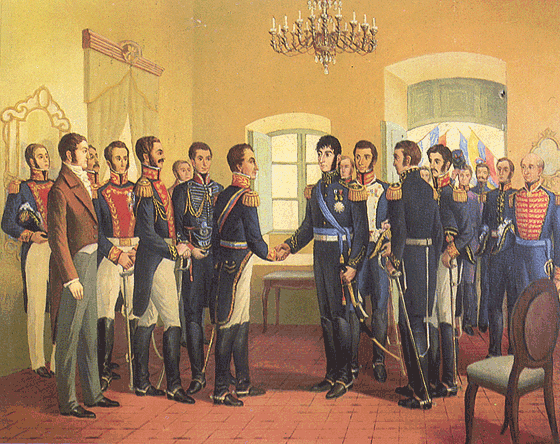
Meeting between Bolivar and San Martin
In June 1824,
Bolivar assembled an army of 9,000 in Peru to move 600 miles over the
Andes to the high plateau. Inadequately clothed, suffering from
sun-blindness, lack of oxygen, and the hazards of the dizzying precipces,
they climbed to 12,000 feet. One English general, a long-time veteran in
Europe, described it as the most difficult military operation he had ever
undertaken.76
At the top,
Bolivar reviewed his troops and told them, "Soldiers, you are about
to finish the greatest undertaking Heaven has confided to men--that of
saving an entire world from salvery!"77
On August 6,
Bolivar reached the heights above the Plains of Junin. Below, he spotted
part of the Spanish army moving across the plains. Bolivar sent 900 of his
horsemen to attack the 2,000 royal cavalry at their rear. The engagement
lasted 45 minutes, no shot was fired during the clash of lances and
swords. The patriots lost 120 men, the Spanish, who retreated in wild
disorder, 400. It was to be the last battle Bolivar would personally lead
against the king's men.78
Bolivar
stepped down to attend to political matters and put nearly 5,780 soldiers
under the command of Sucre. The Peruvian viceroy, La Serna, took 9,300
troops and began to pursue Sucre's forces. A cat and mouse game ensued
through country crossed by steep ravines and deep rivers. Bolivar wrote
Sucre that, "The axiom of Marshal of Saxony is being fulfilled. Feet
spared Peru; feet saved Peru; and feet will again cause Peru to be lost.
Fixed ideas always avenge themselves."79
The Spanish
finally trapped Sucre's army in the valley of Ayacucho on December 9. The
republicans had only one 4-pounder gun, opposed to the crown force's 24
artillery pieces. As the Spanish marched down on the republicans, Sucre
rode along his lines, shouting, "Upon your efforts depend the fate of
South America." Knowing that some of La Serna's subordinates
perpetuated massacres of surrendered troops, the rebels knew it was a
fight to the finish. One of Sucre's lieutenants killed his horse,
explaining to his soldiers, "I have now no means of escape, so we
must fight it out together." The Spanish were startled by the
fierceness of the republican resistance and when the latter charged with
bayonets, the Spanish lost 2,000 men and 15 guns. La Serna was taken
prisoner and the commanding general surrendered.80
Sucre's report
to Bolivar announced, "The war is ended, and the liberation of Peru
completed."81
Mop-up
operations occupied 1825 and in the same year the people of upper Peru
deciding to form a separate nation, which they named Bolivia in Bolivar's
honor. He wrote its constitution and accepted the position of lifetime
president.82
The fight for
the independence of Venezuela, Columbia, Ecuador, Peru, Bolivia, and
Panama (a department of Colombia) had involved 696 battles, with an
average of 1,400 soldiers per engagement, counting both sides together.83
Bolivar
received a letter from the then-old Marquis de Lafayette on behalf of the
family of George Washington, along with a gold medallion coined after the
capitulation at Yorktown. It read, "The second Washington of the New
World." Bolivar was deeply moved.84
Simon Bolivar
began vigorously rebuilding and administering the devastated new states.
He was at the height of his power when he convened a congress of Latin
American republics in Panama in 1826. He envisioned a league of the
fledgling Central and South American nations, but he was far ahead of his
time.85
Soon
thereafter, fighting between the states, personality conflicts, and
resentment of his authoritarian ways caused his influence to wane. After
an assassination attempt and with failing health, Bolivar resigned all his
positions and died shortly thereafter on December 10, 1830.86
But to Latin
Americans, Bolivar remains immortal, one of the greatest military leaders
in the history of the entire world.
SUGGESTED READING...
 huascar.jpg" width="566" height="370">
huascar.jpg" width="566" height="370">
War Along the Pacific Coast.
First Britain. Then Chile. All challenged Peru's Ironclad
Warship Huascar.
It is a story of Bravery, Honour, Technology and Bird Droppings...
ENDNOTES
1. Gerhard
Masur, Simon Bolivar (Albuquerque: University of New Mexico Press,
1948), pp. 11-25. The Encyclopedia Britannica calls Masur's volume the
"best biography of Bolivar in the English language." It should
be available in any good library. Although I consulted half a dozen other
books, all references are to Masur unless otherwise noted.
2. 28
3. 31, 33
4. 37
5. 39
6. 41-43
7. 68
8. 77, 80
9. 79
10. 80
11. 86-89
12. 89
13. 233
14. 92
15. 90-91
16. Lauran Paine,
Bolivar the Liberator (New York: Roy Publishers,
1970), pp. 48-50.
17. 100-101
18. 105
19. 107
20. 114-115
21. 116-117
22. 119
23. 122-125
24. 128
25. 132, 138; Paine 72
26. 144, 148-149; Paine 77
27. Paine 81-86
28. 153
29. 154
30. 159; Paine 81-86
31. 158-159
32. Paine 84-85
33. 160
34. 161
35. 162-3
36. 172
37. Paine 90
38. 165-166
39. 171-172
40. 185
41. 178-179
42. 195-203; Paine 101
43. Paine 101
44. 207
45. 206-219
46. 220-0223
47. 210
48. 231-233
49. F. Loraine Petre,
Simon Bolivar: "El Libertador" (New
York: Best Books, 1924) p. 204.
50. 236
51. 238; Petre vii, 213
52. 245
53. 258
54. 261
55. 263
56. 273; Petre 224
57. 265
58. 266
59. 268; Paine 124, 126; Petre 441
60. 268
61. Bill Boyd,
Bolivar: Liberator of a Continent (New York:S.P.I.
Books,1998), p.93.
62. Petre 441
63. 269-270
64. 271-272
65. 274-277; Paine 129
66. 283-284
67. 292-293
68. 297
69. 304
70. Paine 141-142
71. 323
72. 323-324
73. 325, 328
74. 33-336
75. 337-343
76. 374
77. 374
78. 374-375; Paine 12
79. 377-378
80. 378-379; Paine 172
81. Petre 340
82. 394
83. Boyd viii (re Panama, usually overlooked); the number of battles and
average number of combatants is from Petre 397
84. 399
85. 411
86. 487